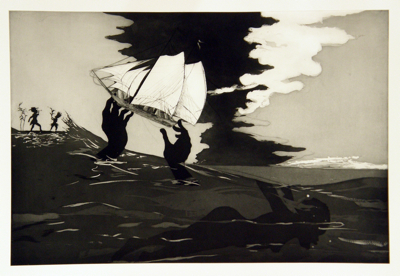- Kara Walker: Cover Art Commentary by Gregg Hertzlieb
Gregg Hertzlieb on Kara Walker: no world

Kara Walker (b. 1969)
no world, 2010
Etching with aquatint, sugar lift, spit bite, and drypoint on paper, V/XXV
Byron Lee and Josephine Luecke Ferguson Donated Fund in honor of Dr. Nina Corazzo
Brauer Museum of Art, 2011.08.001Kara Walker’s original print, no world, is a fine new addition to the Brauer Museum of Art’s permanent collection. Purchased through the Byron Lee and Josephine Luecke Ferguson Donated Fund, this intaglio print on paper represents well the thematically powerful and technically superb work that has established Walker as one of the most important contemporary artists in the United States.
I personally have been meeting with donor Josephine Ferguson, founding museum director Richard Brauer, and Valpo art history professor Nina Corazzo to discuss with them ways for us to spend the money available through Ferguson’s Donated Fund. The four of us as a committee have the most delightful time seeking out fine works of American art to purchase, discussing the merits of particular pieces, identifying collection gaps that need filling, and ultimately selecting objects that have strong visual presence and that offer plentiful opportunities for research and analysis. Dr. Corazzo as a committee member regularly proposes our acquiring works by female artists and artists of color so that the Brauer’s collection can give students a diversity of viewpoints; a piece by Walker was something in particular that Corazzo suggested on numerous occasions. When we looked through Walker’s available works on paper and saw no world, we all knew that it was a good fit for our collection. In addition, Ferguson, Brauer, and I knew that we wanted to dedicate the piece to Corazzo for her wonderful commitment to offering students racially and culturally diverse perspectives. The object’s credit line acknowledges in a lovely fashion a legendary donor, as well as a passionate educator who has done much for the Brauer.
Walker, a young African American artist who in 1997 received a MacArthur “genius” grant, is represented in major museum collections worldwide. Her creations deal with themes of slavery and African American identity in direct, uncompromising, even at times disturbing ways. Typically through silhouetted shapes sometimes taking the form of black paper cutouts affixed directly to the wall, she displays narrative tableaus occasionally fanciful in nature where the characters engage in acts that demonstrate the atrocities of slavery in 19th-century America. Walker’s draftsmanship mimics 19th-century political cartoons, enabling her to bring about potent visual associations while supplying 21st-century postmodern critiques. Her art is of a strong sort, fascinating viewers with pictorial invention while simultaneously confronting them with images unforgettable in their frankness and presentation of man’s inhumanity to man.
no world is available both individually and as part of a portfolio titled An Unpeopled Land in Uncharted Waters. Two large hands in a churning ocean carry a ship, presumably a slave ship, to the shore of the New World, where silhouetted figures seem to represent a landowner bargaining with a native inhabitant for corn. The title no world is a pun on “New World,” and the lower case letters give an opportunity for additional commentary, priming viewers for the experience of seeing the ship carried toward a place unfamiliar, harsh, a destination but not a home for the captives on board. Beneath the waves floats the silhouetted form of a female figure; perhaps it is the artist’s soul, perhaps the collective soul of the people held within the slave ship, perhaps a general indicator of the identity of those people forever lost as the ship leaves the homeland farther and farther behind. no world is a grand, sweeping picture that shows a new land, a transported ship, and a figure beneath the waves that moves viewers tremendously as they contemplate the figure’s tragic inability to act or survive.
History is full of stirring stories, and Walker is able to use dramatic means in her art to suit her historically themed narratives. She aims, however, to subvert the authority of historical accounts and call attention to the participants in these events who were silent and carried along against their will. Her art overall impresses through formal qualities, touches the heart and even summons feelings of outrage through presenting sadly disturbing scenes, and finally captures challenging beauty through the truthfulness of her observations.
As someone with a printmaking background, I must say that no world is a tour de force of intaglio techniques, where the artist uses black, white, and shades of gray in a remarkably effective manner. Walker’s print displays a lovely range of textures and tones that realistically represent the scene and are also satisfying to contemplate as gestural passages. Walker and her accompanying printer were able through surface manipulations of a smooth copper plate to create a broad range of rich tones; corrosive acid etched the plate so that she could achieve a uniform look throughout the proofs and final edition.
no world blends strong critique with exquisite draftsmanship and technique to create an image that captures the imagination and at the same time tells a story that needs to be known, and that should never be forgotten.
Gregg Hertzlieb is Curator and Director of the Brauer Museum of Art at Valparaiso University. Hertzlieb is the editor of the books The Calumet Region: An American Place (Photographs by Gary Cialdella), published in 2009, and Domestic Vision: Twenty-Five Years of the Art of Joel Sheesley (2008), as well as a contributor to The Indiana Dunes Revealed: The Art of Frank V. Dudley (2006). He has been awarded the Edward L. Ryerson Traveling Fellowship by the School of the Art Institute in Chicago and a Conant Writing Award for Poetry from Millikin University. His artwork has been exhibited widely, including at the Aron Packer Gallery, August House Studio, the Central School of Art and Design in London, Columbia College, Elgin Community College, the Goodman Theater, and Struve Gallery.
